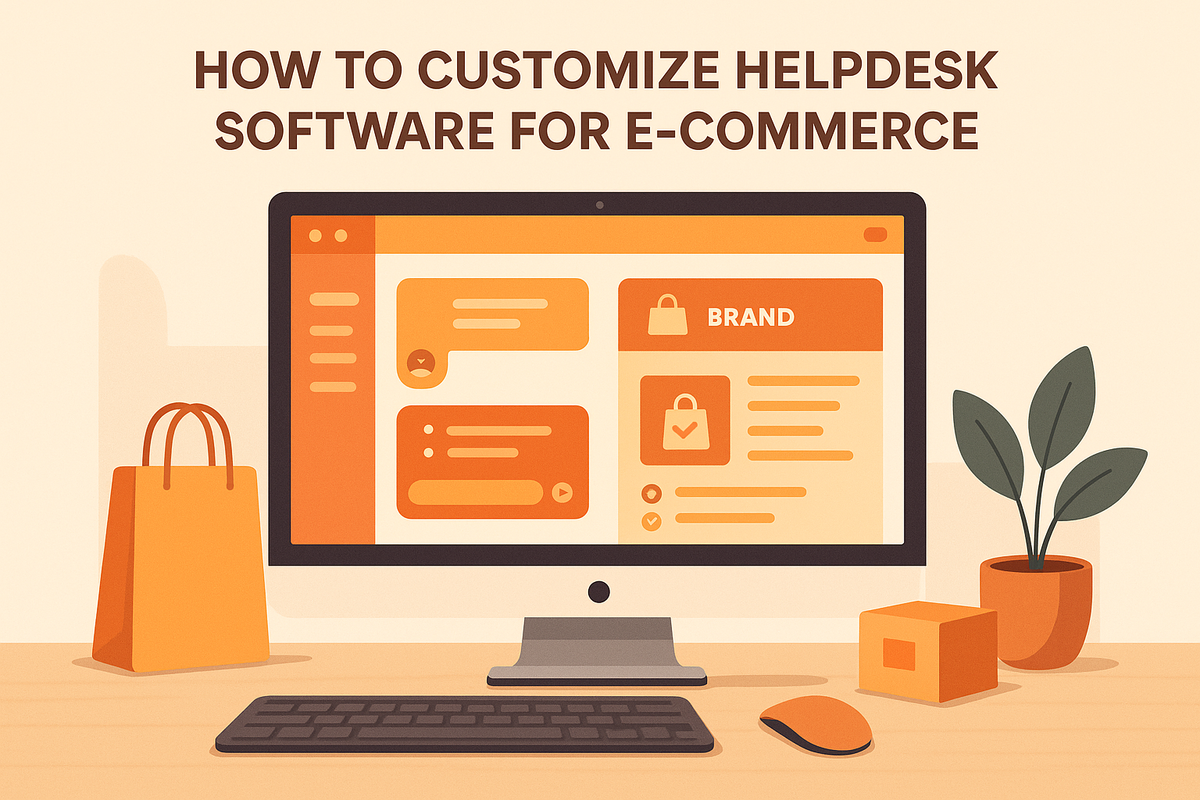How to Customize Helpdesk Software for E-Commerce
Learn how to customize helpdesk software for e-commerce to enhance customer support, streamline operations, and create a cohesive brand experience.

In e-commerce, delivering fast, efficient, and personalized customer support is essential. Here's how to tailor helpdesk software to meet the unique needs of online stores:
- Brand Alignment: Match your helpdesk design (colors, fonts, logos) to your store's branding for a seamless customer experience.
- Language Support: Offer multilingual support based on your audience, ensuring accurate translations and culturally appropriate responses.
- Ticket Management: Organize tickets into categories (e.g., order tracking, refunds) and set automated rules for faster resolutions.
- AI and Automation: Use AI chatbots to handle common issues 24/7, like order status or returns, while training them with store-specific data.
- Integration: Sync helpdesk tools with your e-commerce platform to access customer data (orders, shipping, returns) in one place.
- Performance Tracking: Monitor key metrics like response time (<15 mins) and customer satisfaction (>95%) to maintain quality.
Brand Design and Interface Setup
Make your helpdesk interface match your e-commerce brand to build trust and provide a consistent experience.
Setting Brand Colors and Visual Elements
Align your helpdesk's design with your brand to create a seamless experience:
- Adjust button colors, styles, and hover effects
- Add your logo with proper placement and sizing
- Use fonts that match your website
- Modify the chat window's shape and dimensions
Knowledge Base Branding
- Set up a custom domain (e.g., help.yourstore.com)
- Incorporate branded headers, footers, and consistent navigation
- Match typography and spacing with your website
This ensures customers feel like they're still within your brand's ecosystem, whether they're shopping or seeking help.
Adding Multiple Languages
Understand your customers' language preferences by analyzing their locations, common support languages, and your target audience.
Here’s what language support looks like based on your plan:
| Plan | Languages Supported | Monthly Cost |
|---|---|---|
| Free | 1 language | $0 |
| Starter | 1 language | $49 |
| Growth | 5 languages | $99 |
| Business | Unlimited | $199 |
Chat Interface Translation
Ensure the chat interface automatically adapts to the customer's preferred language. This includes:
- Welcome messages
- Quick reply buttons
- Input field placeholders
- System messages
- Help prompts
Language support isn't just about translating words. Be mindful of cultural nuances and local preferences to make international customers feel appreciated.
Content Management Tips
- Start by creating content in your primary language
- Use clear, straightforward language for easier translation
- Keep terminology consistent across all languages
- Update every language version when making changes
- Test translations with native speakers for accuracy
With your branding and language settings in place, you're ready to focus on optimizing ticket management for smoother support operations.
Ticket Management Setup
Simplify e-commerce support by setting up a ticket management system that reflects your brand and support needs. This system ensures smoother operations and quicker resolutions.
Creating E-Commerce Ticket Categories
Organize tickets into categories to efficiently handle common e-commerce issues:
Main Categories
- Order Status & Tracking: Includes tracking IDs and delivery updates.
- Returns & Refunds
- Payment Issues: Covers failed transactions, billing problems, payment methods, and discount codes.
- Shipping & Delivery
- Product Information
- Account Support
Tip: Use custom fields to automatically capture details like order numbers, tracking IDs, and purchase dates. This saves time for agents by reducing repetitive questions.
Once categories are set, establish rules to assign tickets to the right teams.
Automatic Ticket Assignment Rules
Use routing rules to assign tickets based on priority levels:
High Priority
- Payment failures
- Missing orders
- Incorrect shipments
- Account security concerns
Medium Priority
- Product questions
- Shipping updates
- Return requests
- General inquiries
Low Priority
- Feature suggestions
- Newsletter subscriptions
- Product feedback
Ensure team permissions align with their responsibilities for effective ticket handling.
Team Access and Permissions
Define access levels based on roles to maintain control and efficiency:
Administrator Access
- Manage the entire system and team settings.
- Control analytics and integrations.
Senior Agent Access
- Handle tickets and create templates.
- Oversee the knowledge base and performance.
Standard Agent Access
- Focus on customer support tasks.
- Access basic reporting tools.
Choose a HelpJam plan that fits your team size and business needs:
| Plan | Team Members | Monthly Cost | Best For |
|---|---|---|---|
| Free | 1 | $0 | Solo operators |
| Starter | 5 | $49 | Small stores |
| Growth | 10 | $99 | Mid-size businesses |
| Business | Unlimited | $199 | Large operations |
Security Best Practices
Keep your system secure with these measures:
- Enable two-factor authentication (2FA) for all users.
- Restrict admin access to specific IP addresses.
- Require regular password updates.
- Use audit logs to monitor sensitive actions.
AI and Automation Setup
Boost customer support with AI that works around the clock to handle common questions, all while maintaining a personal touch.
24/7 AI Chat Support Setup
Set up AI to provide instant, round-the-clock support with these steps:
- Upload essential store documents like your sitemap, knowledge base, catalogs, and FAQs.
- Adjust settings to match your brand: choose a GPT version, fine-tune prompts for tone, and set limits on response creativity and speed.
Once live support is running smoothly, focus on configuring automated responses that still feel personal.
Auto-Response Configuration
Develop smart automated replies that are both relevant and engaging:
Common E-Commerce Scenarios
| Scenario | Automated Action | Customer Benefit |
|---|---|---|
| Order Status | Pull tracking details | Get updates instantly |
| Return Requests | Generate return labels | Resolve issues quickly |
| Stock Inquiries | Check inventory data | Confirm availability fast |
| Payment Issues | Verify transaction status | Immediate problem-solving |
Start with these examples, then tweak them based on ongoing data insights.
"Train your AI chatbot using knowledge bases, PDFs, and web pages, automatically indexing articles to stay up-to-date and deliver accurate responses." - HelpJam
AI Learning from Store Data
Enhance your AI's capabilities by training it with your store's historical data:
Key Training Sources
- Past customer interactions and FAQs
- Product descriptions and details
- Resolutions from previous support tickets
- Feedback from customers
Dive into conversation data to find areas for improvement. HelpJam's tools make it easier to:
- Extract key insights from customer interactions
- Spot recurring issues or pain points
- Craft better responses based on past successes
- Automatically update your knowledge base
Pro tip: Set up a smooth transition between AI and human agents for complex issues. This keeps customers happy while optimizing your support system.
E-Commerce Platform Connection
Connect your helpdesk with your e-commerce store to streamline support and provide a seamless customer experience.
Customer and Order Data Integration
To offer better support, having access to all key customer interactions in one place is crucial. HelpJam simplifies this by syncing important customer and order data into a single, easy-to-use interface.
Key Customer Data to Sync:
| Data Type | Benefits | Impact |
|---|---|---|
| Purchase History | Quick access to order details | Resolves order issues faster |
| Shipping Status | Real-time tracking information | Keeps customers updated proactively |
| Return Records | Validates return eligibility | Simplifies the return process |
| Customer Tier | Tailored support levels | Prioritizes VIP customers |
To ensure smooth integration:
- Match customer IDs across systems
- Enable real-time data synchronization
- Set up custom fields for store-specific details
- Include order tracking within support tickets
For advanced integration, use APIs to link your backend systems directly with HelpJam.
Custom Integration Setup
Deep integration allows every customer interaction to be informed by live store data, enhancing your support capabilities.
Use APIs and webhooks to connect your business tools to HelpJam.
Key Integration Points:
| Integration Type | Purpose | Priority Level |
|---|---|---|
| Inventory System | Check stock levels in real time | High |
| Payment Gateway | Verify transactions | High |
| Shipping Partners | Automate tracking updates | Medium |
| Marketing Tools | Access customer segments | Medium |
Tips for Successful Integration:
- Focus on core e-commerce functions first
- Test integrations in a staging environment
- Monitor API usage to avoid performance issues
- Set up error notifications for critical systems
Support Quality Management
With your systems now integrated, it's time to focus on maintaining high-quality support through performance management. Use real-time data and maintenance routines to keep your e-commerce support operations running smoothly. These steps work alongside your tailored workflows and integrations to build a reliable support system.
Performance Metrics Tracking
Real-time analytics dashboards can help you monitor key metrics that directly impact customer satisfaction.
| Metric Category | Key Indicators | Goals |
|---|---|---|
| Response Time | First Reply Time | < 15 minutes |
| Resolution | Time to Resolution | < 24 hours |
| Customer Satisfaction | CSAT Score | > 95% |
| Team Efficiency | Tickets per Agent | 25–30 daily |
These metrics help you:
- Adjust staffing during peak support hours
- Evaluate individual agent performance
- Monitor customer satisfaction trends
- Assess the effectiveness of your knowledge base
Process Problem Detection
Workflows should be analyzed regularly to identify and resolve bottlenecks. Pay attention to these areas:
| Problem Area | Detection Method | Solution Approach |
|---|---|---|
| Recurring Issues | Ticket Tag Analysis | Develop targeted KB articles |
| Response Delays | Time-tracking Reports | Adjust workflow rules |
| Knowledge Gaps | Search Analytics | Update training materials |
| Process Bottlenecks | Workflow Analysis | Simplify approval processes |
"Analyze conversations, resolutions, and response times to help your team stay proactive and responsive to customer needs." - HelpJam
Once identified, implement solutions and secure these improvements with regular updates to ensure long-term reliability.
Regular System Updates
Consistent updates are essential for keeping your support operations effective and efficient.
Weekly Updates:
- Review AI chatbot responses
- Update reply templates
- Verify ticket routing rules
Monthly Updates:
- Evaluate knowledge base performance
- Refresh help articles
- Check team permissions
Quarterly Updates:
- Assess automation workflows
- Update integration settings
- Review overall support processes
HelpJam's AI-powered tools can simplify these updates. Use features like the rich text editor for creating content and conversation analysis tools for refining workflows.
Conclusion
Customizing helpdesk software for e-commerce involves aligning it with your brand, streamlining workflows, and integrating advanced tools. A thoughtful approach can help you build a support system that not only mirrors your brand identity but also delivers exceptional customer service.
Here are four main strategies to focus on:
- Brand Integration: Personalize your interface with your brand’s colors and design elements, while ensuring support is accessible in multiple languages for a global audience.
- Workflow Optimization: Set up ticket categories and automated assignment rules tailored to e-commerce needs to boost efficiency.
- AI Tools: Equip AI chatbots with store-specific data to offer accurate, round-the-clock assistance, speeding up resolutions and improving satisfaction.
- Platform Connection: Use live customer data to provide proactive, needs-based support.
"Help Your Customers At Anytime - No More Support Burden" - HelpJam
To keep your helpdesk system effective, regularly update your knowledge base, refine AI training data, and adjust automation settings. By utilizing advanced analytics and quality management practices, you can ensure your support system keeps pace with your growing e-commerce business.
FAQs
How does connecting my e-commerce platform with helpdesk software enhance customer support efficiency?
Integrating your e-commerce platform with helpdesk software streamlines customer support by centralizing all interactions in one place. This allows your team to handle queries faster and more effectively, even as your business scales.
With features like AI-driven chatbots, live chat, and a searchable knowledge base, you can automate repetitive tasks, provide instant responses, and empower customers to find answers on their own. These tools not only save time but also improve customer satisfaction by delivering seamless, personalized support.
What are the main advantages of using AI and automation in e-commerce customer support systems?
AI and automation bring significant benefits to e-commerce customer support systems by streamlining processes and enhancing customer experiences. For example, AI-powered tools like chatbots can provide instant, accurate responses to customer inquiries, reducing wait times and improving satisfaction.
Automation also boosts efficiency by summarizing conversations, generating quick replies, and proofreading responses, helping support teams work faster and more effectively. Additionally, these tools allow businesses to optimize their workflows, ensuring consistent, high-quality support while saving time and resources.
How can I make sure my helpdesk software handles multiple languages and respects cultural differences?
To ensure your helpdesk software effectively supports multiple languages and respects cultural differences, use tools like a multilingual knowledge base to provide translated articles tailored to your customers' preferred languages. Additionally, customize the chatbox interface to match the language and cultural preferences of your audience, ensuring a seamless and inclusive experience.
By prioritizing localization and cultural sensitivity, you can build stronger connections with your customers and enhance their overall support experience.





